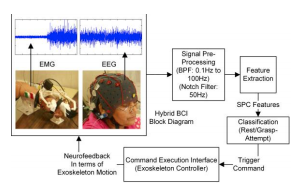Traditionally a Brain-Computer Interface (BCI) system uses Electroencephalogram (EEG) signals for communication and control applications. In recent years different biological signals are also combined with EEG signals to produce hybrid BCI devices to overcome the limitation of lower accuracy rates in BCI. This paper presents a new approach of combining EEG and Electromyogram (EMG) signals using the spectral power correlation (SPC) to create a hybrid BCI device for controlling a hand exoskeleton. The proposed method was tested on 10 healthy individuals for measuring its performance level in terms of accuracy. The EEG-EMG SPC based hybrid BCI was trained to classify the grasp attempt and resting states of the user. Upon successful detection of a grasp attempt, the hybrid BCI triggers the hand exoskeleton to perform a finger flexion-extension motion. The proposed EEG-EMG SPC method is also compared with the conventional only EEG based method which uses common spatial pattern (CSP) based spatial filtering. The results have shown that the proposed EEG-EMG SPC method yielded an average accuracy of 90±4.86% while the conventional EEG-CSP method yielded 79.75±5.71%. This significantly (p<0.02) improved performance in terms of classification accuracy indicates that EEG-EMG SPC based hybrid BCI is a better alternative than the conventional EEG-CSP based BCI to generate hand exoskeleton based neurofeedback.
Presented on 19.02.2020 by Marie Schmidt

